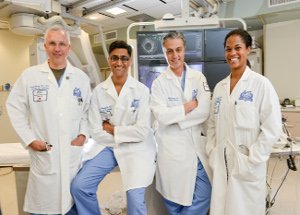What to Expect During a Cardiac Catheterization?
When the time arrives for the procedure to be performed, patients are wheeled into the cardiac catheterization lab and covered by sterile plastic coverings. Intravenous medications, which include a sedative, are given.

The catheter is inserted through a blood vessel in the upper leg or wrist, after the area is numbed with an anesthetic. Patients typically experience little pain or discomfort except during the initial numbing process.
We have a waiting room just outside of the procedure area where your family can wait. Once you are prepped for your procedure your family members may visit you. Once your procedure begins, they will be asked to wait in the waiting room. They may go to the cafeteria or stay in the waiting room. Beepers similar to those supplied at restaurants are available for them should they choose to leave the waiting area.
Once your procedure is finished, someone will notify your family when you are ready for them to come back to visit. At that time a physician will talk to you and your family about the procedure and post-procedure care.
Generally, if you have a diagnostic catheterization you can expect to stay for 2-4 hours following the procedure. If the leg was used as the point of access to the bloodstream, then you will be instructed to keep it straight for a period of time. If the wrist was utilized, you can sit up immediately; you can often eat and drink once the procedure has been completed and the catheter is removed.
Patients who have a therapeutic catheterization usually stay overnight following the procedure. With therapeutic catheterizations, there can be some temporary chest pain during parts of the procedure. These procedures take longer than diagnostic catheterizations. In a few situations, it is safe for you to be discharged the same day even following a therapeutic intervention. If you are identified as being able to be discharged the same day of your intervention, it will be discussed with you during your stay.
.svg?iar=0&hash=F6049510E33E4E6D8196C26CCC0A64A4)

/hfh-logo-main--white.svg?iar=0&hash=ED491CBFADFB7670FAE94559C98D7798)